How Many Hours Of Makeup For Planet Of The Apes 2001
Why Tim Burton'southward 'Planet of the Apes' Is a Masterclass Of Mask Acting
There'southward no monkeying around in these masks
A few years ago, at an exhibition of his work in Melbourne, Australia, Tim Burton named several films that had an influence on his career. Among the titles was Dracula A.D. 1972 , a movie that even many an addict of Hammer horror can't count as a good film. Burton acknowledged its shortcomings. "I think Hammer was on the reject, and they idea, 'hey, allow's get hip,'" he said, "which was a mistake. But I enjoy mistakes sometimes." Burton is no stranger to accusations of having made mistakes, and no film of his faces the charge more often than 2001's Planet of the Apes .
This is a film you may have heard is bad. That it was a negative turning point in Burton's career. That information technology was disaster that demanded some other reboot of the franchise. The concluding betoken is piece of cake enough to refute past checking its box function have. The mixed critical and fan response may well take motivated Flim-flam to pursue some other direction, just the film made plenty of money. I would dispute the second charge too; Burton's side by side film after Apes was Big Fish , and he's gone on to peachy work like Corpse Bride , Sweeney Todd , and Big Eyes .
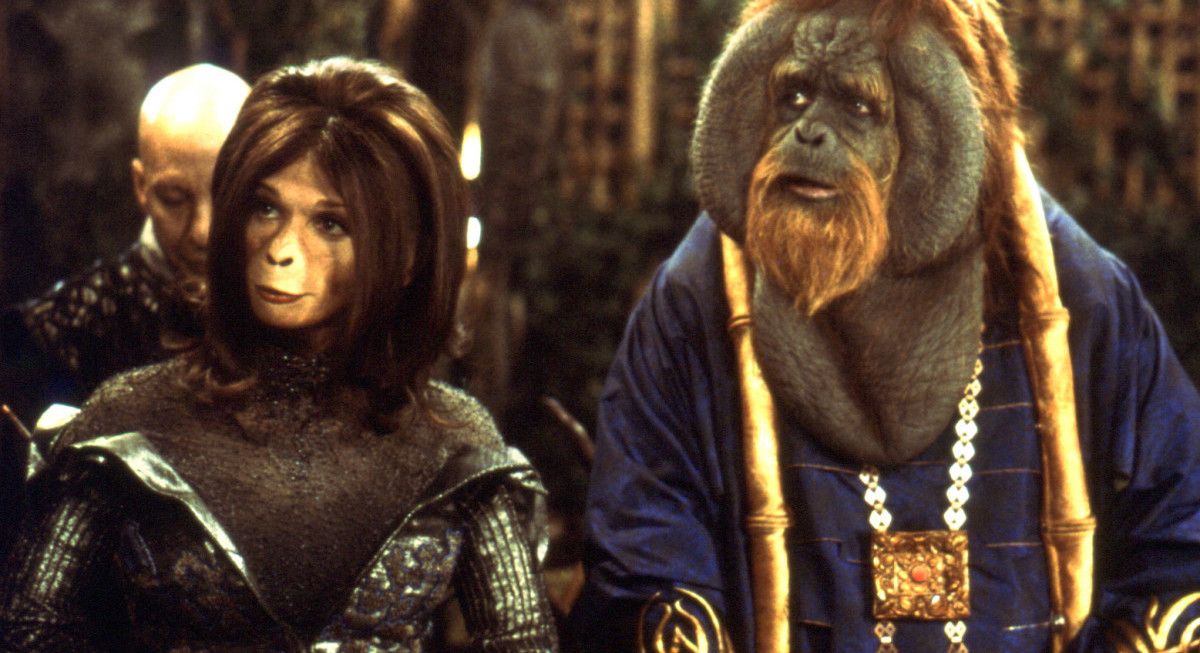
As to the claim that the movie is bad – I'll give you that i. Every bit a narrative, information technology'southward thin, uneven, and fraying at the seams. The inflexible release date set past Trick resulted in a rushed production period with extensive on-set rewrites to a long-gestating script, and in recounting the experience for the book Burton on Burton , the manager speculated that had he been able to start from scratch, he would have made a completely different picture. Only if 2001's Apes a mess, it's a fun mess. It'southward a "reimagining" that holds true to the implication of that term, existence a completely new take on the concept of a planet of apes without attempting to retell the story of the original picture (an undeniably superior effort). And there are good pieces to the film, the acting amongst the strongest of them.
A cast boasting the likes of Tim Roth, Paul Giamatti, and Helena Bonham Carter would have talent to spare no matter the script, but Burton's Apes is a showcase for a item skill: mask interim. Rick Baker's brilliant make-up submerged all the ape actors underneath pounds of foam latex and yak hair, obliging them to project through all that cover to deliver their performances. Giamatti in detail excelled at working his face through the rubber, but every ape in the film from Michael Clarke Duncan to supporting actors like Glenn Shadix animated their appliances and offered upwards fully expressive characters.
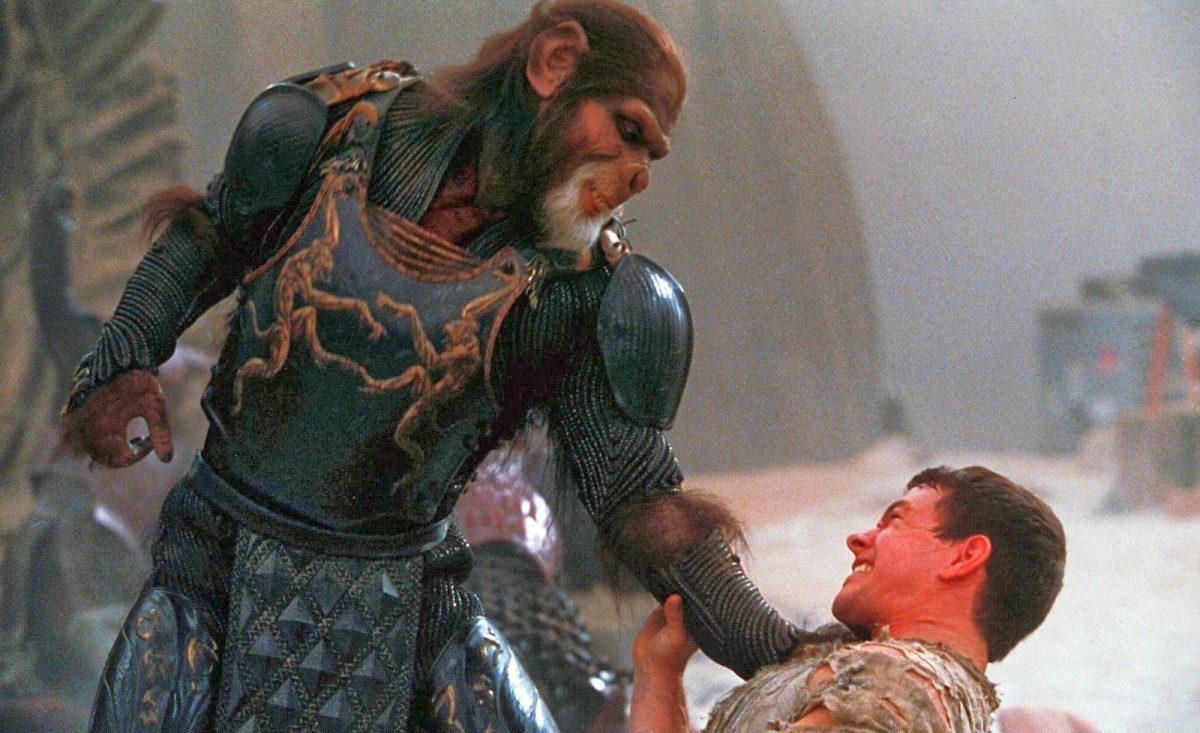
All fine, you say, simply what makes Planet of the Apes and then special in this regard? The original had great actors working through masks too, so do scores of other movies. Merely 2 things stand out well-nigh the mask acting of Apes: the integration of the masks into a larger concept for the ape characters, and a bespeak of comparison with the move capture apes of the Caesar trilogy of recent years.
The all-time conceptual element of the 2001 Apes' story is that of a more than primitive ape culture (compared with the 1968 original) in a land of flux. These apes do not have guns, agricultural fields, or a regimented class system that extends all the way down to species-specific uniforms. The apes of Ashlar (the planet's name unspoken in the film itself) vesture plated armor in boxing or on the hunt, all the same dwell in the copse and the woods floor, and merely display prejudice toward the human being race. Their civilization retains many traits of "animalistic" apes: preparation, inquisitively exploring objects and sentient beings with their hands, and more continued and communal dwellings.
All this factors into the brand-up and costumes designed by Bakery and Colleen Atwood. The apes here don't take the evolved standardized faces past species of the original series. Every ape has a unique look, and they all adhere much more than closely to existent ape features: the sagittal crests of gorillas, the flanges of orangutans, the variety of coloring on chimpanzees. Oversized dentures distorted the actors' faces to work with the make-upwardly and affect their expressions. Without animatronic enhancement, this is as close as the homo face can get to an ape's through make-up. These wonderful masks were married to a carefully adult approximation of ape motility to enhance the result. There were no arm extensions used to try and simulate the proportions of apes as we know them. Instead, Atwood's careful cutting of outfits and muscle nether suits suggested longer arms and shorter legs, while the movement illustrated a social club that had evolved up to oral communication, housing, and government simply yet retained some of their animal roots.
Merely how deep those roots go is the flux that this culture finds itself in. Across the DVD commentary for Apes, Burton speaks about how terrifying and "psychotic" chimpanzees can be, in contrast to their public image as cute, curious, and affectionate. This dichotomy made its manner into the film through the characters of Thade (Roth) and Ari (Carter). I'd hesitate to telephone call Ari "cute," only she is the most inquisitive and warm-hearted of the ape characters, in stark contrast to Thade's unpredictable rages and violence. The two characters represent different perspectives from this ape culture on how to deal with human being beings. Ari, liberal-minded if still holding benign prejudice, is disgusted by the use of humans for slave labor and hopes to reach equality for them. Thade, full general of the ground forces, heir to the secrets of Ashlar'south ii civilizations, wishes to go beyond enslaving humans to wiping them out entirely.
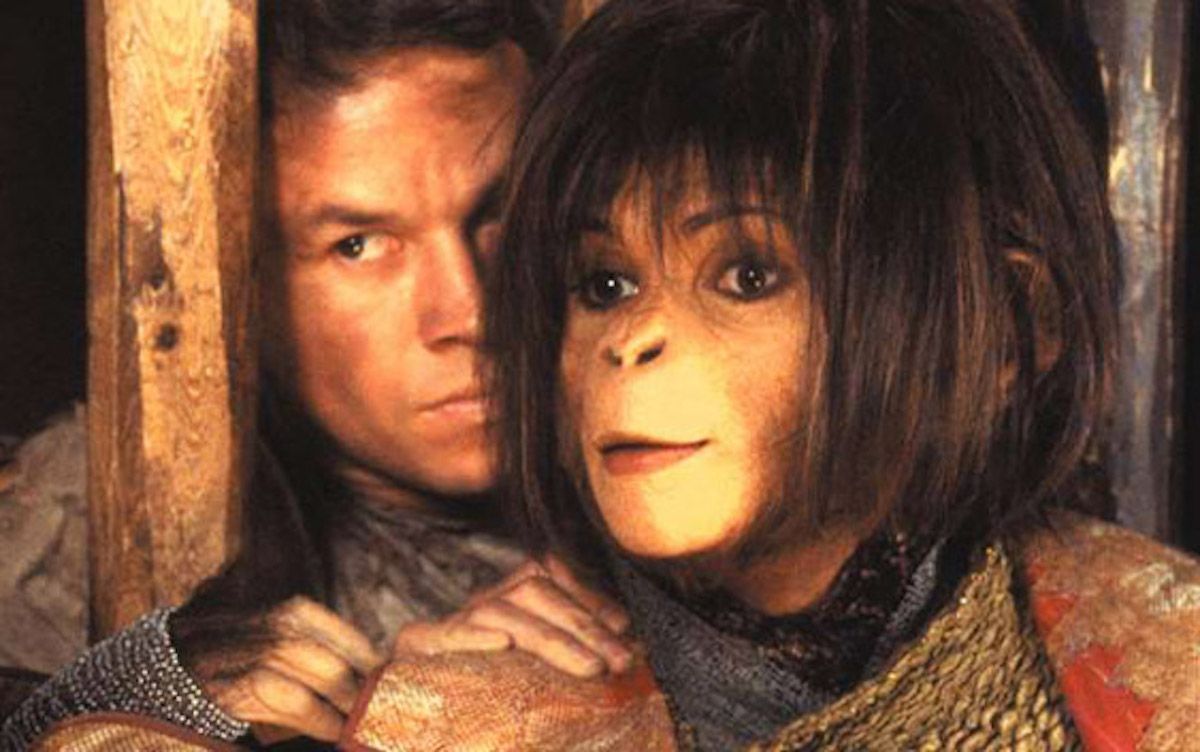
This disharmonism is carried over into the characters' make-upwardly and movement. Ari, while non almost as humanized as the chimpanzees of the original serial, has softer features than any other chimpanzee in the motion picture, and her movement is a little closer to natural human being gait. Thade'southward brand-upwardly is a closer approximation to real chimps, and he has a much lower, animalistic walk paired with the sudden bursts of acrobatic free energy yous can find in apes. While these two characters best personify this tension, it permeates throughout the primate bandage. Having to incorporate all these notions of a young, evolving civilisation still clinging to animal traits on top of working with latex appliances is a very tall gild for any actor, but the cast pulled it off. The civilization of the original Planet of the Apes was no less defined than Burton'due south but because the story is and so much weaker in his film, the exploration of the world stands out the more. Given further back up by Rick Heinrichs's vertical wood metropolis and Danny Elfman's eclectic, percussion-heavy score, information technology really does feel like a earth depart, and I wish the pic could have been a "day in the life" exploration of this society and its tensions rather than a platitude escape plot with a big, impaired battle at the end.
As for the comparison with more recent Apes trilogy: for as long every bit at that place'southward been acting, at that place have been actors who don't enjoy costumes and make-upwardly. In the age of moving picture, appliances of the type used by Baker and his squad for Burton'due south apes tin can have hours to apply and remove. Some are allergic to the adhesives, some are claustrophobic when submerged in the mask, and some discover it annoying and uncomfortable. They would rather work with their own face. Move capture provides that pick. It's been described as an advancement over prosthetics; Andy Serkis has routinely called it "digital make-upwardly."
But it doesn't take away from the talents of actors cast in motion-capture roles, or the digital artists who take over in post, to say that at that place is a tangible deviation between that kind of piece of work and a performance given through a physical mask. This holds true for whatsoever comparison between digital and practical tools: it'due south all hard piece of work, just a different sort of difficult work. Practical objects tin can be photographed just equally they are, can modify looks under natural and manmade sources of lite without any wizardry, tin move and flex and bend and break. When information technology comes to interim, masks besides have direct physical affect on actors. They can't move their faces the same way they normally would and have their operation properly annals. If they have giant ape dentures, every bit Burton's cast did, they can't speak the way they normally would. Costumes and muscle undersuits lock in posture and limit movement, and present cuts of fabrics that can become in the fashion when caught by the wind or snagged in a prepare or location.
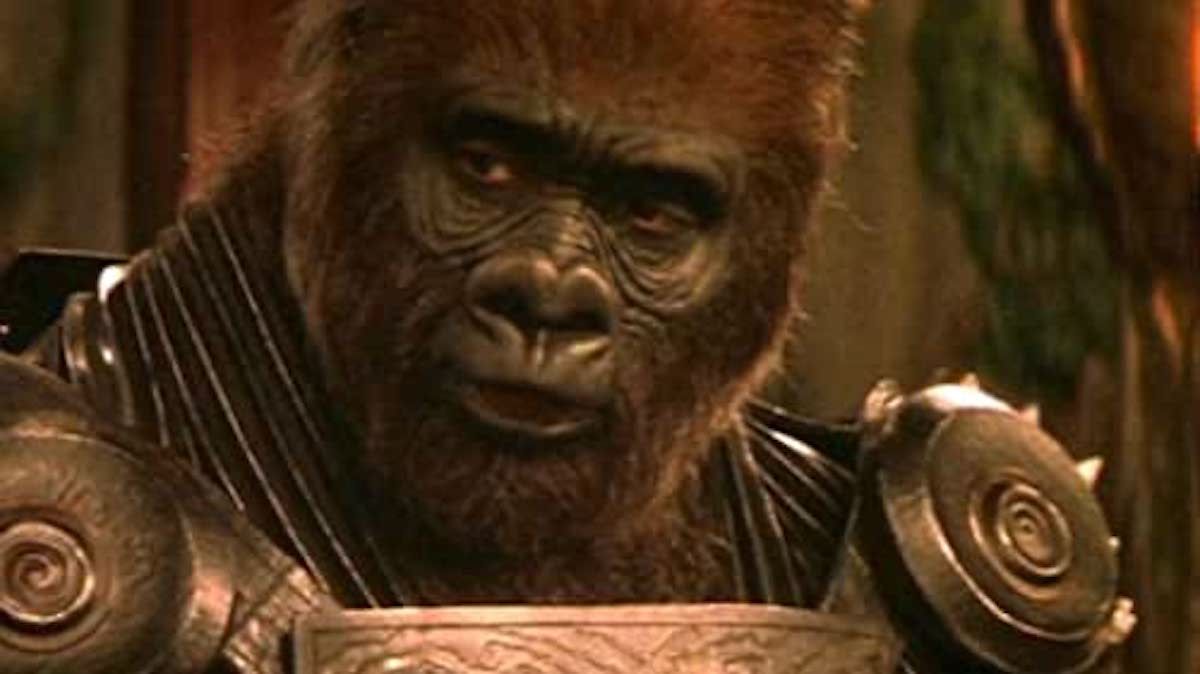
This forces actors to adjust their performances. They act in means they wouldn't human action if they weren't encumbered past make-up. It brings something new out of them. Some actors can't come across that challenge, or simply don't desire to. Others savor it or, if they don't, at least make lemonades out of lemons. It doesn't detract from Serkis's work as Caesar to say that Paul Giamatti'south Limbo is a different experience for a viewer. The latter is an orangutan who was clearly there, in locations and on practical sets. His rotted teeth are huge, his nose is flattened by appliances, his ambling gait and sloppy posture don't friction match how even the near slovenly of united states walks, and all the same it's withal clearly a human being within concrete appliances and wardrobe, performing wild takes and wonderful bits of physical one-act.
Duncan as the far more than stoic Attar hadn't the gratis rein to emote to that caste, only he was able to find a more subtle expression of his character and have it register through latex. Tim Roth – whose "big olfactory organ" (Baker's words) were sick-suited to the ape make-up, necessitating thicker safety pieces – could still sell going apeshit through all that prophylactic and a adjust of armor more tailored for an ape'due south physique than his ain. To run into them – to see all of this cast – create such expressive characters, role of a solid conception of an ape culture, all through practical ways, is a wonderful experience. Without diminishing the digital choice, I will always prefer the former arroyo.
And if that arroyo is attached to a story that doesn't work and a movie that doesn't gel, that amounts to a big mistake? Well, to quote an expert on the discipline, I bask mistakes sometimes.
Nigh The Author
Source: https://collider.com/planet-of-the-apes-tim-burton-why-its-good/
Posted by: ozunaweland.blogspot.com

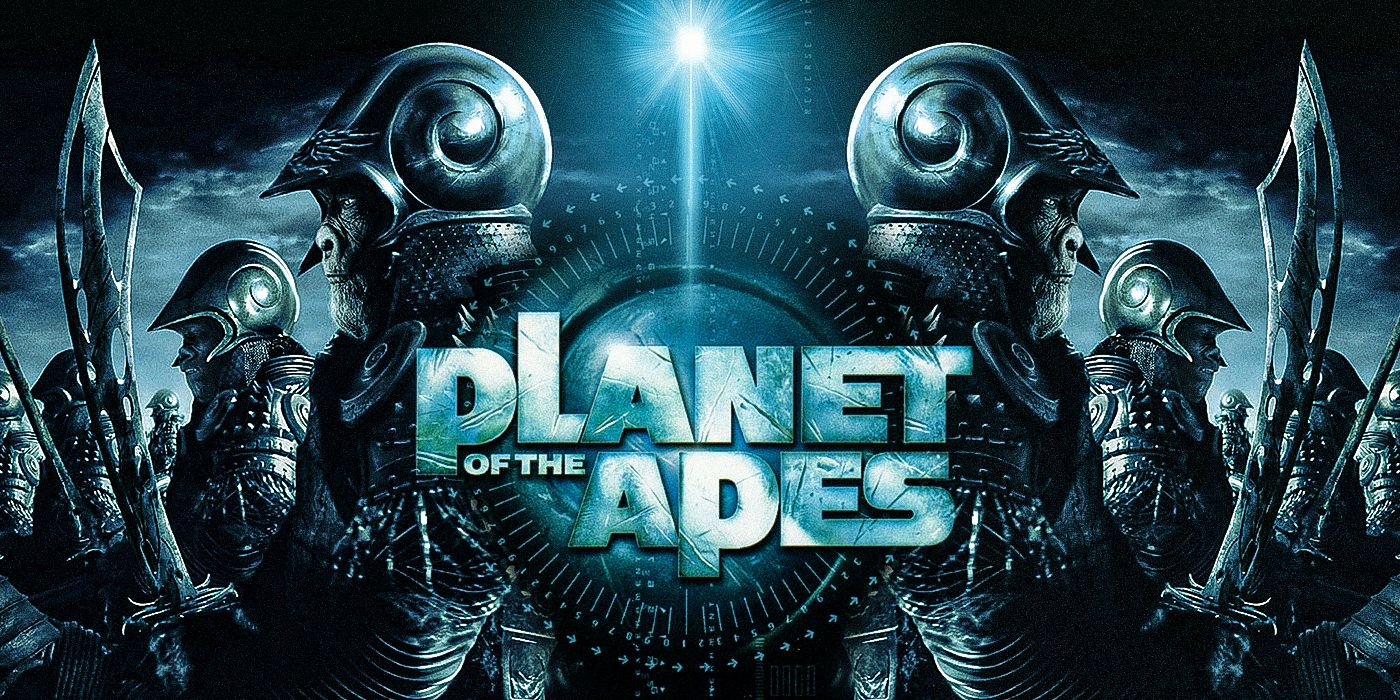
.png?fit=crop&w=100&h=100)
0 Response to "How Many Hours Of Makeup For Planet Of The Apes 2001"
Post a Comment